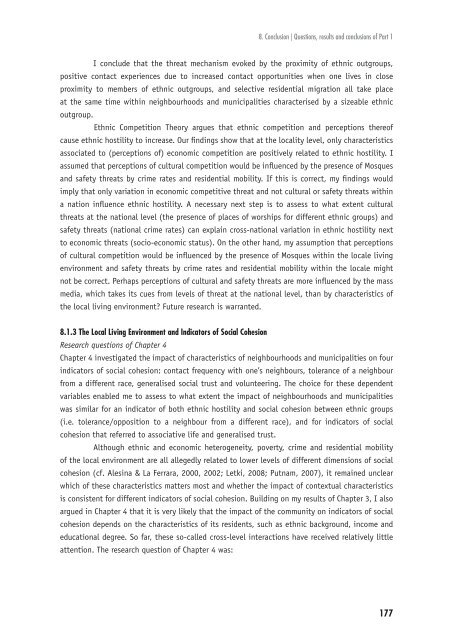Ethnic Hostility among Ethnic Majority and Minority Groups
Ethnic Hostility among Ethnic Majority and Minority Groups
Ethnic Hostility among Ethnic Majority and Minority Groups
Create successful ePaper yourself
Turn your PDF publications into a flip-book with our unique Google optimized e-Paper software.
8. Conclusion | Questions, results <strong>and</strong> conclusions of Part 1<br />
I conclude that the threat mechanism evoked by the proximity of ethnic outgroups,<br />
positive contact experiences due to increased contact opportunities when one lives in close<br />
proximity to members of ethnic outgroups, <strong>and</strong> selective residential migration all take place<br />
at the same time within neighbourhoods <strong>and</strong> municipalities characterised by a sizeable ethnic<br />
outgroup.<br />
<strong>Ethnic</strong> Competition Theory argues that ethnic competition <strong>and</strong> perceptions thereof<br />
cause ethnic hostility to increase. Our fi ndings show that at the locality level, only characteristics<br />
associated to (perceptions of) economic competition are positively related to ethnic hostility. I<br />
assumed that perceptions of cultural competition would be infl uenced by the presence of Mosques<br />
<strong>and</strong> safety threats by crime rates <strong>and</strong> residential mobility. If this is correct, my fi ndings would<br />
imply that only variation in economic competitive threat <strong>and</strong> not cultural or safety threats within<br />
a nation infl uence ethnic hostility. A necessary next step is to assess to what extent cultural<br />
threats at the national level (the presence of places of worships for different ethnic groups) <strong>and</strong><br />
safety threats (national crime rates) can explain cross-national variation in ethnic hostility next<br />
to economic threats (socio-economic status). On the other h<strong>and</strong>, my assumption that perceptions<br />
of cultural competition would be infl uenced by the presence of Mosques within the locale living<br />
environment <strong>and</strong> safety threats by crime rates <strong>and</strong> residential mobility within the locale might<br />
not be correct. Perhaps perceptions of cultural <strong>and</strong> safety threats are more infl uenced by the mass<br />
media, which takes its cues from levels of threat at the national level, than by characteristics of<br />
the local living environment? Future research is warranted.<br />
8.1.3 The Local Living Environment <strong>and</strong> Indicators of Social Cohesion<br />
Research questions of Chapter 4<br />
Chapter 4 investigated the impact of characteristics of neighbourhoods <strong>and</strong> municipalities on four<br />
indicators of social cohesion: contact frequency with one’s neighbours, tolerance of a neighbour<br />
from a different race, generalised social trust <strong>and</strong> volunteering. The choice for these dependent<br />
variables enabled me to assess to what extent the impact of neighbourhoods <strong>and</strong> municipalities<br />
was similar for an indicator of both ethnic hostility <strong>and</strong> social cohesion between ethnic groups<br />
(i.e. tolerance/opposition to a neighbour from a different race), <strong>and</strong> for indicators of social<br />
cohesion that referred to associative life <strong>and</strong> generalised trust.<br />
Although ethnic <strong>and</strong> economic heterogeneity, poverty, crime <strong>and</strong> residential mobility<br />
of the local environment are all allegedly related to lower levels of different dimensions of social<br />
cohesion (cf. Alesina & La Ferrara, 2000, 2002; Letki, 2008; Putnam, 2007), it remained unclear<br />
which of these characteristics matters most <strong>and</strong> whether the impact of contextual characteristics<br />
is consistent for different indicators of social cohesion. Building on my results of Chapter 3, I also<br />
argued in Chapter 4 that it is very likely that the impact of the community on indicators of social<br />
cohesion depends on the characteristics of its residents, such as ethnic background, income <strong>and</strong><br />
educational degree. So far, these so-called cross-level interactions have received relatively little<br />
attention. The research question of Chapter 4 was:<br />
177












